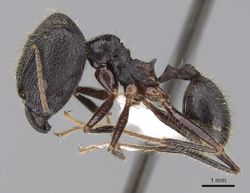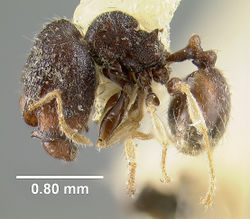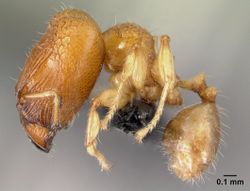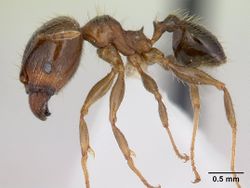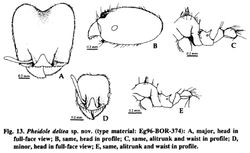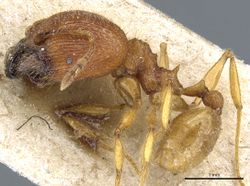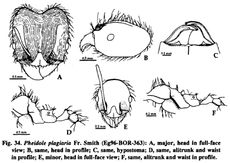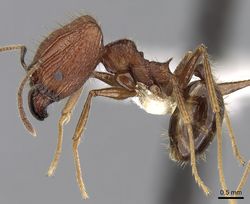Key to Pheidole majors of Borneo
This worker key is based on: Eguchi, K. 2001a. A revision of the Bornean species of the ant genus Pheidole (Insecta: Hymenoptera: Formicidae: Myrmicinae). Tropics Monograph Series. 2:1-154.
Because the major of P. gombakensis sp. nov. has not been collected from Borneo, the major from Ulu Gombak, southern Malay Peninsula are used for making the keys “A” and “C.”
You may also be interested in
1
- Antenna with 3-segmented club . . . . . 6
- Antenna with 5-segmented club, or without conspicuous club . . . . . 2
2
return to couplet #1
- Apical five antennal segments forming conspicuous club; hypostoma bearing three low median processes; subpetiolar process low, with ventral margin carinate . . . . . 3
- Antenna lacking conspicuous club; hypostoma lacking distinct median processes; subpetiolar process absent . . . . . 4
3
return to couplet #2
- Head in profile distinctly impressed on vertex . . . . . Pheidole quinata
- Head in profile not, or only slightly, impressed on vertex . . . . . Pheidole sabahna
4
return to couplet #2
- Dorsum of promesonotal dome in front of the prominence on its posterior declivity bearing 10-20 standing hairs; propodeal spine at least 3.5 times as long as diameter of propodeal spiracle; body light brown to reddish brown . . . . . Pheidole montana
- Dorsum of promesonotal dome in front of the prominence on posterior declivity bearing less than 10 standing hairs in Pheidole singaporensis , or ca. 20 standing hairs in Pheidole comata; propodeal spine usually at most 2.5 times as long as diameter of propodeal spiracle; body reddish brown to dark brown . . . . . 5
5
return to couplet #4
- Head densely bearing standing hairs over the surface; lateral face of occipital lobe distinctly rugose; dorsum of promesonotal dome in front of the prominence on its posterior declivity bearing ca. 20 standing hairs . . . . . Pheidole comata
- Head with sparse standing hairs only on frons and vertex; lateral face of occipital lobe weakly and finely rugose, or almost smooth and shining; dorsum of promesonotal dome in front of the prominence on its posterior declivity bearing at most 10 standing hairs . . . . . Pheidole singaporensis
6
return to couplet #1
- Promesonotum armed with a pair of long and pointed spines; hypostoma always bearing a pair of stout median processes . . . . . 7
- Promesonotum unarmed, or each dorsolateral portion of promesonotum produced outward (e.g., Pheidole aristotelis), but never armed with long and pointed spines; hypostoma bearing 0-3 median processes . . . . . 11
7
return to couplet #6
- Gaster smooth and shining over the surface, or only anterior part of first gastral tergite near its articulation with postpetiole weakly punctured; petiolar node in profile acute at apex . . . . . Pheidole acantha
- At least first gastral tergite punctured or rugoso-punctured and dull over the surface; petiolar node in profile blunt at apex . . . . . 8
8
return to couplet #7
- Propodeal spine digitiform and blunt apically; alitrunk sparsely covered with relatively short standing hairs . . . . . Pheidole quadricuspis
- Propodeal spine horn-like or elongate-triangular, pointed apically; alitrunk covered with relatively long standing hairs . . . . . 9
9
return to couplet #8
- Propodeal spine elongate-triangular with broad base . . . . . Pheidole quadrensis
- Propodeal spine horn-like with narrow base . . . . . 10
10
return to couplet #9
- Body larger (e.g., HW 2.79-2.91 mm); subpetiolar process completely absent . . . . . Pheidole lokitae
- Body smaller (e.g., HW 1.73-2.12 mm); petiole with very low subpetiolar process . . . . . Pheidole spinicornis
11
return to couplet #6
- Legs from apex of femur to apex of tarsus ivory-white, contrasted with remainder of femur which is dark brown . . . . . Pheidole fantasia
- Legs almost unicolored . . . . . 12
12
return to couplet #11
- Frontal lobe extremely developed, extending beyond anterior margin of clypeus . . . . . Pheidole upeneci
- Frontal lobe sometimes developed, but never extending beyond anterior margin of clypeus . . . . . 13
13
return to couplet #12
- Eye consisting of 5-7 ommatidia; terminal segment of antenna more than 1.6 times as long as preceding two segments together . . . . . Pheidole parvicorpus
- Eye consisting of at least 10 ommatidia; terminal segment of antenna at most 1.3 times as long as preceding two segments together . . . . . 14
14
return to couplet #13
- Frons irregularly reticulate; hypostoma bearing a stout median process; frontal carina horizontal, extensively overhanging antennal scrobe; each dorsolateral portion of promesonotal dome produced outward . . . . . Pheidole aristotelis
- Frons longitudinally rugose; hypostoma bearing 0-3 median processes; the condition of frontal carina and antennal scrobe variable; each dorsolateral portion of promesonotal dome sometimes produced outward . . . . . 15
15
return to couplet #14
- Masticatory margin of mandible having two denticles before basal angle; ventral faces of midcoxa and hindcoxa distinctly reticulate (this condition exclusively shared with Pheidole aristotelis among others) . . . . . 16
- Masticatory margin of mandible having at most one denticle before basal angle; ventral faces of midcoxa and hindcoxa completely smooth and shining . . . . . 20
16
return to couplet #15
- Lateral portion of clypeus developed into a horn . . . . . Pheidole clypeocornis
- Lateral portion of clypeus never developed into a horn . . . . . 17
17
return to couplet #16
- Outer face of mandible sculptured with rugulae running from its base toward its masticatory margin . . . . . Pheidole rugifera
- Outer face of mandible smooth and shining, or rugose laterally only around its base . . . . . 18
18
return to couplet #17
- Frons (the area between frontal carinae) reticulate in its posterior part where spaces enclosed by rugulae punctured and dull . . . . . Pheidole tenebricosa
- Frons longitudinally rugose or rugoso-reticulate in its posterior part where spaces enclosed by rugulae almost smooth and shining . . . . . 19
19
return to couplet #18
- Frons in profile relatively flat . . . . . Pheidole hortensis
- Frons in profile relatively convex . . . . . Pheidole kikutai
20
return to couplet #15
- Frontal carina horizontal, extensively overhanging antennal scrobe; hypostoma always bearing one large median process . . . . . 21
- Frontal carina sometimes well developed, but not overhanging antennal scrobe extensively; hypostoma bearing 0-3 median processes . . . . . 23
21
return to couplet #20
- Clypeus having a distinct median longitudinal carina . . . . . Pheidole retivertex
- Clypeus lacking a median longitudinal carina . . . . . 22
22
return to couplet #21
- Frontal lobe well developed and suberect; frons sparsely covered with longitudinal rugulae . . . . . Pheidole tjibodana
- Frontal lobe poorly developed; frons densely covered with longitudinal rugulae ...... . . . . . Pheidole sayapensis
23
return to couplet #20
- Each dorsolateral portion of promesonotum produced as a stout horn; eye small (distance between mandibular insertion and anterior margin of eye 2.1-2.6 times as long as maximal diameter of eye); postpetiole broad (2.3-2.8 times as broad as petiolar node) . . . . . Pheidole angulicollis
- Each dorsolateral portion of promesonotum sometimes produced but not forming a stout horn; eye variable in size (distance between mandibular insertion and anterior margin of eye usually less than twice as long as maximal diameter of eye); postpetiole variable in width (usually less than 2.3 times as broad as petiolar node) . . . . . 24
24
return to couplet #23
- Petiolar node in profile highly prominent; hypostoma always bearing a pair of median processes; occasionally the processes poorly developed in P. elisae Emery); mesopleuron divided by a transverse impression into two parts, of which lower part is always margined dorsally; alitrunk, or at least its large part, smooth and shining . . . . . 25
- Petiolar node in profile usually poorly prominent (with exceptions as seen in Pheidole bugi, in which, however, hypostoma bears three similar-sized median processes); when mesopleuron divided by a transverse impression into two parts, lower part is usually not margined dorsally (with exceptions as seen in Pheidole poringensis, in which alitrunk is reticulate) . . . . . 27
25
return to couplet #24
- Dorsum of head completely covered with longitudinal rugulae . . . . . Pheidole sauberi
- Dorsum of occipital lobe smooth and shining . . . . . 26
26
return to couplet #25
- Eight ommatidia present on longest axis of eye . . . . . Pheidole elisae
- Four to five ommatidia present on longest axis of eye . . . . . Pheidole sarawakana
27
return to couplet #24
- Alitrunk completely lacking standing hairs . . . . . Pheidole huberi
- Alitrunk bearing standing hairs . . . . . 28
28
return to couplet #27
- Propodeal spine extremely long, extending over petiolar node . . . . . Pheidole modiglianii
- Propodeal spine at most slightly passing posterior end of propodeal lobe . . . . . 29
29
return to couplet #28
- Dorsum of occipital lobe smooth and shining (or only weakly and sparsely rugose in Pheidole manukana where postpetiole 2.4-2.6 times as broad as petiolar node) . . . . . 30
- Dorsum of head including that of occipital lobe completely sculptured (or rugulae on occipital lobe weak in Pheidole orophila sp. nov. where, however, postpetiole 1.6-1.7 times as broad as petiolar node) . . . . . 36
30
return to couplet #29
- Hypostoma always lacking median processes; petiole less than 1.2 times as long as postpetiole . . . . . 31
- Hypostoma bearing 1-3 median processes; (in part of Pheidole lucioccipitalis hypostoma lacks all the median processes where petiole is more than 1.5 times as long as postpetiole) . . . . . 33
31
return to couplet #30
- Distance between mandibular insertion and anterior margin of eye ca. 2.3-2.4 times as long as maximal diameter of eye . . . . . Pheidole havilandi
- Distance between mandibular insertion and anterior margin of eye 1.4-1.6 times as long as maximal diameter of eye . . . . . 32
32
return to couplet #31
- Postpetiole 2.4-2.6 times as broad as petiolar node; frontal carina conspicuous . . . . . Pheidole manukana
- Postpetiole 1.8-1.9 times as broad as petiolar node; frontal carina inconspicuous . . . . . Pheidole megacephala
33
return to couplet #30
- Posterior declivity of promesonotal dome having a distinct prominence . . . . . Pheidole plinii
- Posterior declivity of promesonotal dome lacking a distinct prominence . . . . . 34
34
return to couplet #33
- Hypostoma bearing an indistinct median process, or lacking median process; clypeus having a median longitudinal carina . . . . . Pheidole lucioccipitalis
- Hypostoma bearing 2-3 median processes; clypeus lacking a conspicuous median longitudinal carina . . . . . 35
35
return to couplet #34
- Promesonotum narrower dorsally than ventrally . . . . . Pheidole deltea
- Promesonotum broader dorsally than ventrally . . . . . Pheidole merimbun
36
return to couplet #29
- Posterior declivity of promesonotal dome lacking a distinct prominence; if the declivity has an inconspicuous prominence (as seen in Pheidole poringensis), hypostoma bearing 2-3 distinct median processes . . . . . 37
- Posterior declivity of promesonotal dome having a distinct prominence; if the declivity has just an inconspicuous prominence (as seen in Pheidole submonticola), hypostoma completely lacking median processes . . . . . 43
37
return to couplet #36
- Frontal lobe relatively large and erect . . . . . Pheidole tawauensis
- Frontal lobe relatively small . . . . . 38
38
return to couplet #37
- Posterior margin of head weakly concave in full-face view; dorsum of promesonotum smooth and shining (with several rugulae) . . . . . Pheidole planidorsum
- Posterior margin of head strongly concave in full-face view; dorsum of promesonotum sculptured or smooth . . . . . 39
39
return to couplet #38
- Hypostoma bearing three median processes . . . . . 40
- Hypostoma bearing a pair of stout median processes; if hypostoma bears three median processes, then the medianmost one is much reduced (as seen in Pheidole rabo and Pheidole poringensis) . . . . . 41
40
return to couplet #39
- Petiolar node relatively high . . . . . Pheidole parva
- Petiolar node relatively low . . . . . Pheidole butteli
41
return to couplet #39
- Petiole almost twice as long as postpetiole (excluding helcium); lateral face of promesonotum almost smooth and shining . . . . . Pheidole gombakensis
- Petiole at most 1.7 times as long as postpetiole (excluding helcium); lateral face of promesonotum sculptured . . . . . 42
42
return to couplet #41
- Petiole ca. 1.7 times as long as postpetiole (excluding heIcium); outer face of mandible sparsely covered with very short appressed hairs . . . . . Pheidole rabo
- Petiole 1.3-1.4 times as long as postpetiole (excluding heIcium); outer face of mandible sparsely covered with relatively long decumbent hairs . . . . . Pheidole poringensis
43
return to couplet #36
- Hypostoma bearing three low median processes, of which each lateral one is partly combined with the process just mesal to mandibular insertion . . . . . Pheidole annexa
- If hypostoma bears 2-3 median processes, then each lateral one is never combined with the process just mesal to mandibular insertion . . . . . 44
44
return to couplet #43
- Hypostoma bearing a pair of stout median processes ; petiole almost as long as postpetiole which is relatively massive . . . . . Pheidole ghigii
- If hypostoma bears a pair of small or indistinct median processes, then petiole is at least 1.2 times as long as postpetiole . . . . . 45
45
return to couplet #44
- Propodeal spine elongate-triangular, with broad base; outer face of mandible bearing short or very short, appressed hairs . . . . . 46
- Propodeal spine horn-like, with narrow base; outer face of mandible usually bearing relatively long, appressed or decumbent hairs . . . . . 47
46
return to couplet #45
- Antennal scrobe margined below with a conspicuous carina anteriorly; mesopleuron without a distinct transverse impression . . . . . Pheidole cariniceps
- Antennal scrobe present only around antennal insertion, and never margined below with a conspicuous carina; mesopleuron divided by a transverse impression into two parts, of which lower part margined dorsally . . . . . Pheidole submonticola
47
return to couplet #45
- Posteriormost part of dorsum of occipital lobe almost transversely rugose . . . . . Pheidole plagiaria
- Dorsum of occipital lobe sculptured, but never transversely rugose . . . . . 48
48
return to couplet #46
- Frontal carina weak; lateral face of occipital lobe smooth or very weakly rugoso-punctured . . . . . Pheidole jacobsoni
- Frontal carina distinct; lateral face of occipital lobe distinctly rugoso-reticulate . . . . . 49
49
return to couplet #48
- Posterior margin of head strongly concave in full-face view . . . . . Pheidole aglae
- Posterior margin of head weakly concave in full-face view . . . . . 50
50
return to couplet #49
- Distance between mandibular insertion and anterior margin of eye 1.3-1.4 times as long as maximal diameter of eye . . . . . Pheidole fervens
- Distance between mandibular insertion and anterior margin of eye 1.7-2.0 times as long as maximal diameter of eye . . . . . Pheidole inornata







